Analysis of HRM Problems at 'No Name' Aircraft: Recommendations
VerifiedAdded on 2023/01/19
|12
|3767
|62
Report
AI Summary
This report examines the human resource management issues confronting 'No Name' aircraft, an Australian-based international firm with subsidiaries in China and Vietnam. The analysis identifies critical problems such as a poor organizational culture characterized by employee reluctance to embrace change and a lack of diversity in its workforce, leading to potential legal issues. Furthermore, the report highlights deficiencies in international performance management, including a lack of performance appraisal processes and inadequate training and development opportunities. The report then proposes HRM strategies to address these challenges, including fostering a positive organizational culture through feedback and communication, implementing effective diversity policies, adopting international performance appraisal systems, and improving training and career development programs. Finally, it provides detailed recommendations and an implementation plan designed to mitigate the identified issues and improve the company's overall performance and customer satisfaction.
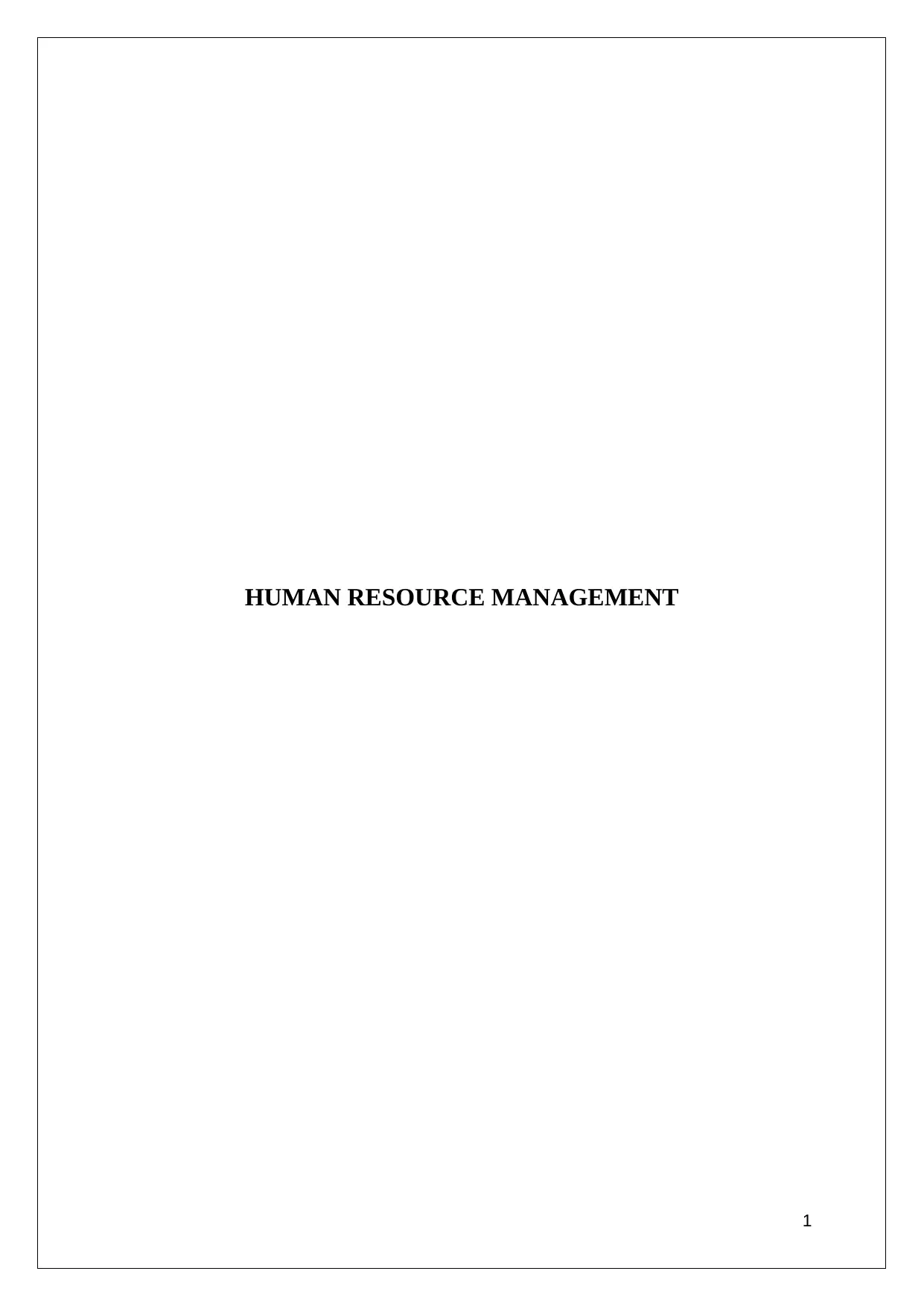
HUMAN RESOURCE MANAGEMENT
1
1
Paraphrase This Document
Need a fresh take? Get an instant paraphrase of this document with our AI Paraphraser

Executive summary
In this report, different issues that ‘No Name’ aircraft is facing are discussed. Different HR
issues are currently faced by this Australian aircraft firm. This is impacting in their
performance and decreasing satisfaction rate of customers. Different issues like lack of
diversity, poor organizational culture. Poor international performance management and
training opportunities are discussed in detailed. In addition, ways of HRM to deal with these
issues are identified and evaluated. This includes steps of framing good organizational culture
and decision making process and training strategies. Proper recommendations are given with
implementation plan at the end of this report, which will help this company to mitigate the
current issues.
2
In this report, different issues that ‘No Name’ aircraft is facing are discussed. Different HR
issues are currently faced by this Australian aircraft firm. This is impacting in their
performance and decreasing satisfaction rate of customers. Different issues like lack of
diversity, poor organizational culture. Poor international performance management and
training opportunities are discussed in detailed. In addition, ways of HRM to deal with these
issues are identified and evaluated. This includes steps of framing good organizational culture
and decision making process and training strategies. Proper recommendations are given with
implementation plan at the end of this report, which will help this company to mitigate the
current issues.
2
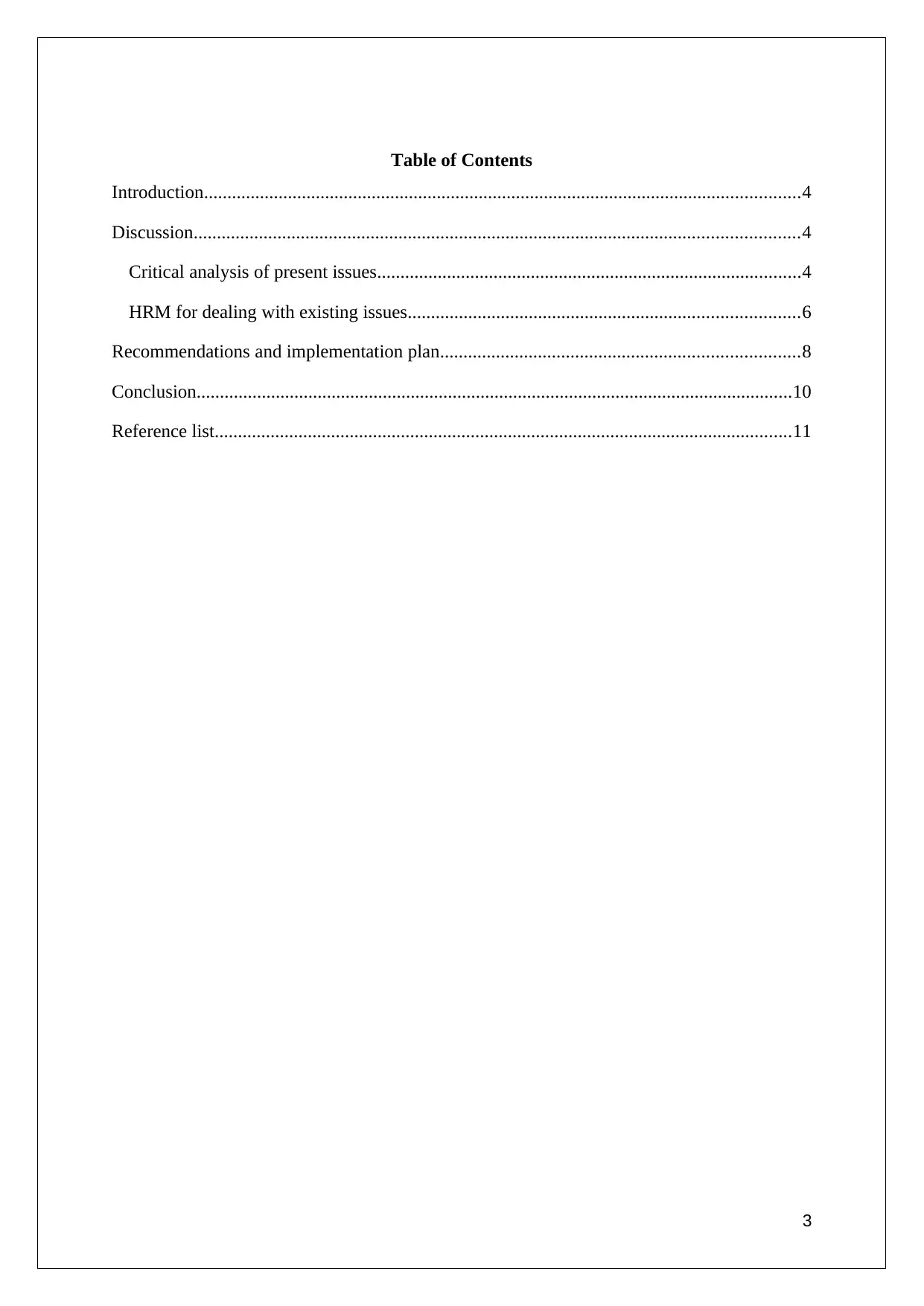
Table of Contents
Introduction................................................................................................................................4
Discussion..................................................................................................................................4
Critical analysis of present issues...........................................................................................4
HRM for dealing with existing issues....................................................................................6
Recommendations and implementation plan.............................................................................8
Conclusion................................................................................................................................10
Reference list............................................................................................................................11
3
Introduction................................................................................................................................4
Discussion..................................................................................................................................4
Critical analysis of present issues...........................................................................................4
HRM for dealing with existing issues....................................................................................6
Recommendations and implementation plan.............................................................................8
Conclusion................................................................................................................................10
Reference list............................................................................................................................11
3
⊘ This is a preview!⊘
Do you want full access?
Subscribe today to unlock all pages.

Trusted by 1+ million students worldwide

Introduction
Improper human resource management gives rise to several issues, which impacts on
performance of an organization. Main purpose of this report is to identify several issues of
‘No Name’ aircraft and providing different solutions for mitigating the issues. ‘No Name’ is
an international firm that is based in Australia. However, it has subsidiaries located in China
and Vietnam. This firm builds and distributes aircraft to 50 countries different HRM issues
like organizational culture and diversity that impacts on overall performance of this firm. The
case study discusses various HRM issues, which needs to be mitigated to maximize
shareholders ROI and increase revenue collection of the company. Scope of this report
includes detailed description and impact of the issues that ‘No Name’ is facing currently. In
addition, different solutions to the issues are also included in the scope of this report. Detailed
implementation plan of recommendations has also been given in this report.
Discussion
Critical analysis of present issues
‘No Name’ is facing various issues at present and it is affecting the business performance.
This company is currently facing various issues and effective human resource management
can help to mitigate these issues.
i. Issues of organizational culture
As opined by Harzing and Pinningto (2010), organizational culture affects financial
performance and it must be maintained to satisfy needs of customers. The present case study
is postulating that organizational culture of ‘No Name’ is very poor as employees are not
providing their best effort to ensure benefit for this company. Staffs are showing reluctant to
provide their best effort to this company. Management of this company has realized that their
staffs are not ready to accept change in organizational culture. It means that learning
opportunities are missing and skills of employees are not getting improved. This issue can be
considered as potent enough to the level of customer satisfaction. As argued by Tarique et al.
(2015), employees resist change as they fear to lose their comfort of working. However, it
can be seen that management of this company has failed to make employees understand the
importance of implementation of change within organization.
4
Improper human resource management gives rise to several issues, which impacts on
performance of an organization. Main purpose of this report is to identify several issues of
‘No Name’ aircraft and providing different solutions for mitigating the issues. ‘No Name’ is
an international firm that is based in Australia. However, it has subsidiaries located in China
and Vietnam. This firm builds and distributes aircraft to 50 countries different HRM issues
like organizational culture and diversity that impacts on overall performance of this firm. The
case study discusses various HRM issues, which needs to be mitigated to maximize
shareholders ROI and increase revenue collection of the company. Scope of this report
includes detailed description and impact of the issues that ‘No Name’ is facing currently. In
addition, different solutions to the issues are also included in the scope of this report. Detailed
implementation plan of recommendations has also been given in this report.
Discussion
Critical analysis of present issues
‘No Name’ is facing various issues at present and it is affecting the business performance.
This company is currently facing various issues and effective human resource management
can help to mitigate these issues.
i. Issues of organizational culture
As opined by Harzing and Pinningto (2010), organizational culture affects financial
performance and it must be maintained to satisfy needs of customers. The present case study
is postulating that organizational culture of ‘No Name’ is very poor as employees are not
providing their best effort to ensure benefit for this company. Staffs are showing reluctant to
provide their best effort to this company. Management of this company has realized that their
staffs are not ready to accept change in organizational culture. It means that learning
opportunities are missing and skills of employees are not getting improved. This issue can be
considered as potent enough to the level of customer satisfaction. As argued by Tarique et al.
(2015), employees resist change as they fear to lose their comfort of working. However, it
can be seen that management of this company has failed to make employees understand the
importance of implementation of change within organization.
4
Paraphrase This Document
Need a fresh take? Get an instant paraphrase of this document with our AI Paraphraser
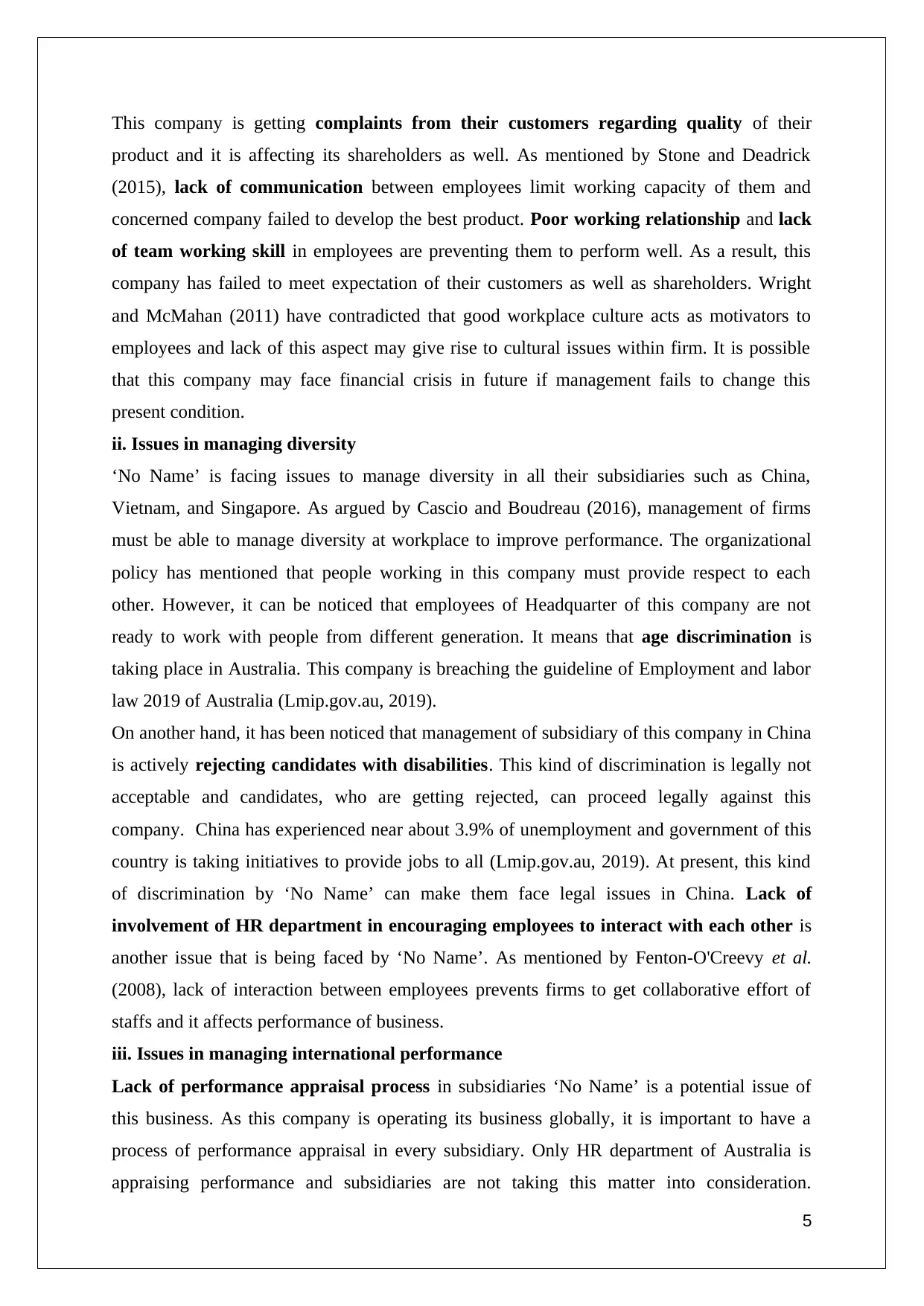
This company is getting complaints from their customers regarding quality of their
product and it is affecting its shareholders as well. As mentioned by Stone and Deadrick
(2015), lack of communication between employees limit working capacity of them and
concerned company failed to develop the best product. Poor working relationship and lack
of team working skill in employees are preventing them to perform well. As a result, this
company has failed to meet expectation of their customers as well as shareholders. Wright
and McMahan (2011) have contradicted that good workplace culture acts as motivators to
employees and lack of this aspect may give rise to cultural issues within firm. It is possible
that this company may face financial crisis in future if management fails to change this
present condition.
ii. Issues in managing diversity
‘No Name’ is facing issues to manage diversity in all their subsidiaries such as China,
Vietnam, and Singapore. As argued by Cascio and Boudreau (2016), management of firms
must be able to manage diversity at workplace to improve performance. The organizational
policy has mentioned that people working in this company must provide respect to each
other. However, it can be noticed that employees of Headquarter of this company are not
ready to work with people from different generation. It means that age discrimination is
taking place in Australia. This company is breaching the guideline of Employment and labor
law 2019 of Australia (Lmip.gov.au, 2019).
On another hand, it has been noticed that management of subsidiary of this company in China
is actively rejecting candidates with disabilities. This kind of discrimination is legally not
acceptable and candidates, who are getting rejected, can proceed legally against this
company. China has experienced near about 3.9% of unemployment and government of this
country is taking initiatives to provide jobs to all (Lmip.gov.au, 2019). At present, this kind
of discrimination by ‘No Name’ can make them face legal issues in China. Lack of
involvement of HR department in encouraging employees to interact with each other is
another issue that is being faced by ‘No Name’. As mentioned by Fenton-O'Creevy et al.
(2008), lack of interaction between employees prevents firms to get collaborative effort of
staffs and it affects performance of business.
iii. Issues in managing international performance
Lack of performance appraisal process in subsidiaries ‘No Name’ is a potential issue of
this business. As this company is operating its business globally, it is important to have a
process of performance appraisal in every subsidiary. Only HR department of Australia is
appraising performance and subsidiaries are not taking this matter into consideration.
5
product and it is affecting its shareholders as well. As mentioned by Stone and Deadrick
(2015), lack of communication between employees limit working capacity of them and
concerned company failed to develop the best product. Poor working relationship and lack
of team working skill in employees are preventing them to perform well. As a result, this
company has failed to meet expectation of their customers as well as shareholders. Wright
and McMahan (2011) have contradicted that good workplace culture acts as motivators to
employees and lack of this aspect may give rise to cultural issues within firm. It is possible
that this company may face financial crisis in future if management fails to change this
present condition.
ii. Issues in managing diversity
‘No Name’ is facing issues to manage diversity in all their subsidiaries such as China,
Vietnam, and Singapore. As argued by Cascio and Boudreau (2016), management of firms
must be able to manage diversity at workplace to improve performance. The organizational
policy has mentioned that people working in this company must provide respect to each
other. However, it can be noticed that employees of Headquarter of this company are not
ready to work with people from different generation. It means that age discrimination is
taking place in Australia. This company is breaching the guideline of Employment and labor
law 2019 of Australia (Lmip.gov.au, 2019).
On another hand, it has been noticed that management of subsidiary of this company in China
is actively rejecting candidates with disabilities. This kind of discrimination is legally not
acceptable and candidates, who are getting rejected, can proceed legally against this
company. China has experienced near about 3.9% of unemployment and government of this
country is taking initiatives to provide jobs to all (Lmip.gov.au, 2019). At present, this kind
of discrimination by ‘No Name’ can make them face legal issues in China. Lack of
involvement of HR department in encouraging employees to interact with each other is
another issue that is being faced by ‘No Name’. As mentioned by Fenton-O'Creevy et al.
(2008), lack of interaction between employees prevents firms to get collaborative effort of
staffs and it affects performance of business.
iii. Issues in managing international performance
Lack of performance appraisal process in subsidiaries ‘No Name’ is a potential issue of
this business. As this company is operating its business globally, it is important to have a
process of performance appraisal in every subsidiary. Only HR department of Australia is
appraising performance and subsidiaries are not taking this matter into consideration.
5
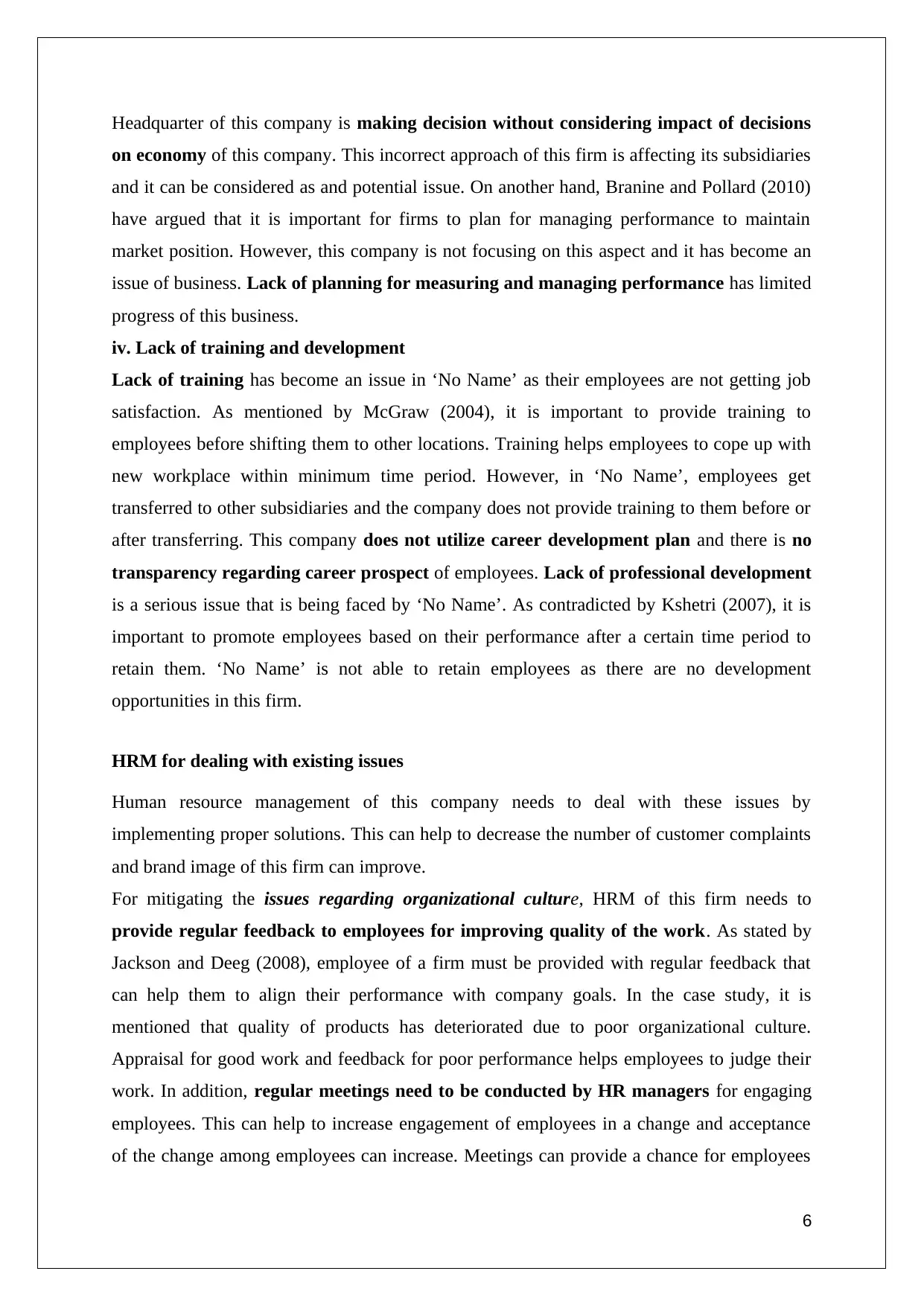
Headquarter of this company is making decision without considering impact of decisions
on economy of this company. This incorrect approach of this firm is affecting its subsidiaries
and it can be considered as and potential issue. On another hand, Branine and Pollard (2010)
have argued that it is important for firms to plan for managing performance to maintain
market position. However, this company is not focusing on this aspect and it has become an
issue of business. Lack of planning for measuring and managing performance has limited
progress of this business.
iv. Lack of training and development
Lack of training has become an issue in ‘No Name’ as their employees are not getting job
satisfaction. As mentioned by McGraw (2004), it is important to provide training to
employees before shifting them to other locations. Training helps employees to cope up with
new workplace within minimum time period. However, in ‘No Name’, employees get
transferred to other subsidiaries and the company does not provide training to them before or
after transferring. This company does not utilize career development plan and there is no
transparency regarding career prospect of employees. Lack of professional development
is a serious issue that is being faced by ‘No Name’. As contradicted by Kshetri (2007), it is
important to promote employees based on their performance after a certain time period to
retain them. ‘No Name’ is not able to retain employees as there are no development
opportunities in this firm.
HRM for dealing with existing issues
Human resource management of this company needs to deal with these issues by
implementing proper solutions. This can help to decrease the number of customer complaints
and brand image of this firm can improve.
For mitigating the issues regarding organizational culture, HRM of this firm needs to
provide regular feedback to employees for improving quality of the work. As stated by
Jackson and Deeg (2008), employee of a firm must be provided with regular feedback that
can help them to align their performance with company goals. In the case study, it is
mentioned that quality of products has deteriorated due to poor organizational culture.
Appraisal for good work and feedback for poor performance helps employees to judge their
work. In addition, regular meetings need to be conducted by HR managers for engaging
employees. This can help to increase engagement of employees in a change and acceptance
of the change among employees can increase. Meetings can provide a chance for employees
6
on economy of this company. This incorrect approach of this firm is affecting its subsidiaries
and it can be considered as and potential issue. On another hand, Branine and Pollard (2010)
have argued that it is important for firms to plan for managing performance to maintain
market position. However, this company is not focusing on this aspect and it has become an
issue of business. Lack of planning for measuring and managing performance has limited
progress of this business.
iv. Lack of training and development
Lack of training has become an issue in ‘No Name’ as their employees are not getting job
satisfaction. As mentioned by McGraw (2004), it is important to provide training to
employees before shifting them to other locations. Training helps employees to cope up with
new workplace within minimum time period. However, in ‘No Name’, employees get
transferred to other subsidiaries and the company does not provide training to them before or
after transferring. This company does not utilize career development plan and there is no
transparency regarding career prospect of employees. Lack of professional development
is a serious issue that is being faced by ‘No Name’. As contradicted by Kshetri (2007), it is
important to promote employees based on their performance after a certain time period to
retain them. ‘No Name’ is not able to retain employees as there are no development
opportunities in this firm.
HRM for dealing with existing issues
Human resource management of this company needs to deal with these issues by
implementing proper solutions. This can help to decrease the number of customer complaints
and brand image of this firm can improve.
For mitigating the issues regarding organizational culture, HRM of this firm needs to
provide regular feedback to employees for improving quality of the work. As stated by
Jackson and Deeg (2008), employee of a firm must be provided with regular feedback that
can help them to align their performance with company goals. In the case study, it is
mentioned that quality of products has deteriorated due to poor organizational culture.
Appraisal for good work and feedback for poor performance helps employees to judge their
work. In addition, regular meetings need to be conducted by HR managers for engaging
employees. This can help to increase engagement of employees in a change and acceptance
of the change among employees can increase. Meetings can provide a chance for employees
6
⊘ This is a preview!⊘
Do you want full access?
Subscribe today to unlock all pages.

Trusted by 1+ million students worldwide
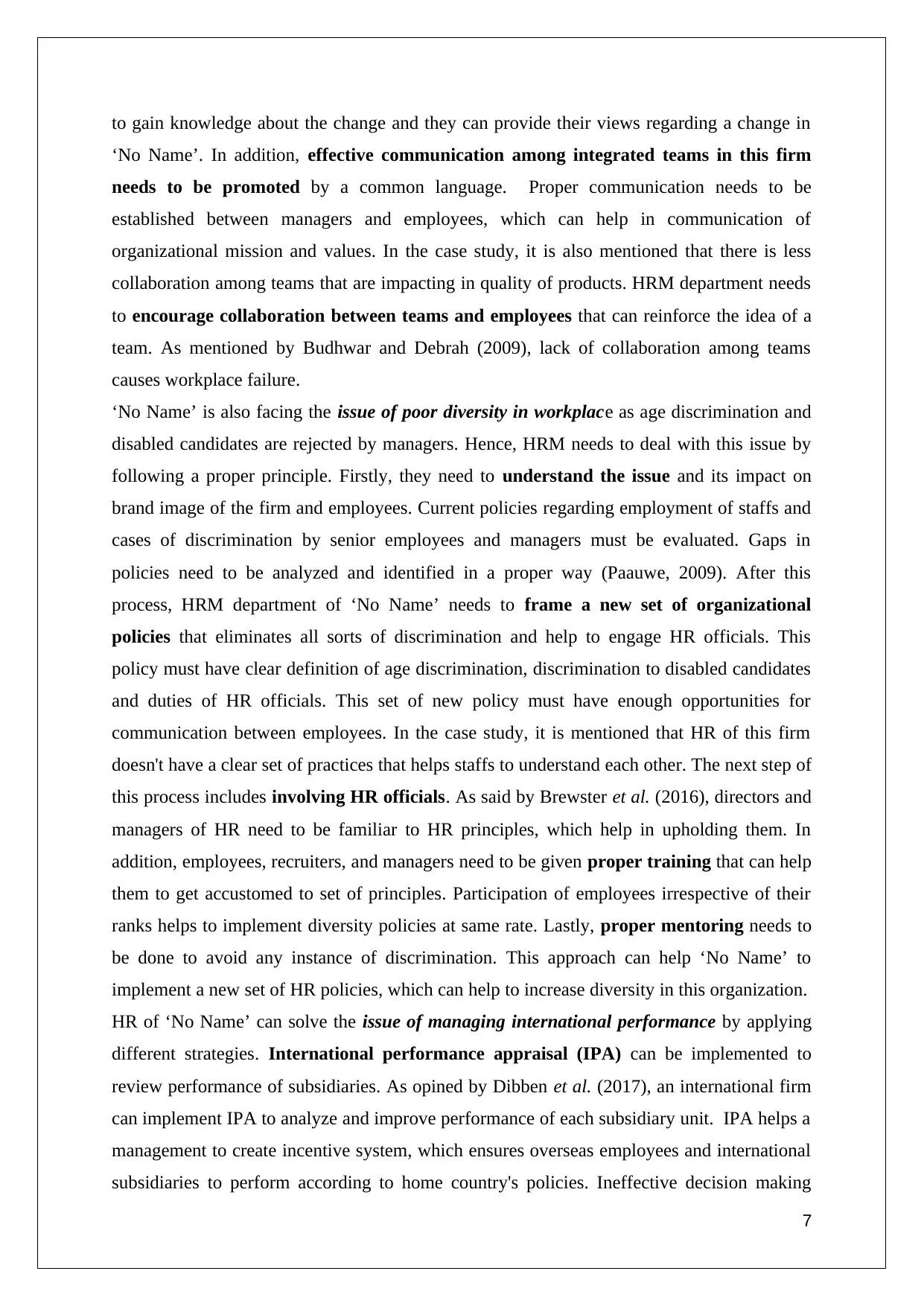
to gain knowledge about the change and they can provide their views regarding a change in
‘No Name’. In addition, effective communication among integrated teams in this firm
needs to be promoted by a common language. Proper communication needs to be
established between managers and employees, which can help in communication of
organizational mission and values. In the case study, it is also mentioned that there is less
collaboration among teams that are impacting in quality of products. HRM department needs
to encourage collaboration between teams and employees that can reinforce the idea of a
team. As mentioned by Budhwar and Debrah (2009), lack of collaboration among teams
causes workplace failure.
‘No Name’ is also facing the issue of poor diversity in workplace as age discrimination and
disabled candidates are rejected by managers. Hence, HRM needs to deal with this issue by
following a proper principle. Firstly, they need to understand the issue and its impact on
brand image of the firm and employees. Current policies regarding employment of staffs and
cases of discrimination by senior employees and managers must be evaluated. Gaps in
policies need to be analyzed and identified in a proper way (Paauwe, 2009). After this
process, HRM department of ‘No Name’ needs to frame a new set of organizational
policies that eliminates all sorts of discrimination and help to engage HR officials. This
policy must have clear definition of age discrimination, discrimination to disabled candidates
and duties of HR officials. This set of new policy must have enough opportunities for
communication between employees. In the case study, it is mentioned that HR of this firm
doesn't have a clear set of practices that helps staffs to understand each other. The next step of
this process includes involving HR officials. As said by Brewster et al. (2016), directors and
managers of HR need to be familiar to HR principles, which help in upholding them. In
addition, employees, recruiters, and managers need to be given proper training that can help
them to get accustomed to set of principles. Participation of employees irrespective of their
ranks helps to implement diversity policies at same rate. Lastly, proper mentoring needs to
be done to avoid any instance of discrimination. This approach can help ‘No Name’ to
implement a new set of HR policies, which can help to increase diversity in this organization.
HR of ‘No Name’ can solve the issue of managing international performance by applying
different strategies. International performance appraisal (IPA) can be implemented to
review performance of subsidiaries. As opined by Dibben et al. (2017), an international firm
can implement IPA to analyze and improve performance of each subsidiary unit. IPA helps a
management to create incentive system, which ensures overseas employees and international
subsidiaries to perform according to home country's policies. Ineffective decision making
7
‘No Name’. In addition, effective communication among integrated teams in this firm
needs to be promoted by a common language. Proper communication needs to be
established between managers and employees, which can help in communication of
organizational mission and values. In the case study, it is also mentioned that there is less
collaboration among teams that are impacting in quality of products. HRM department needs
to encourage collaboration between teams and employees that can reinforce the idea of a
team. As mentioned by Budhwar and Debrah (2009), lack of collaboration among teams
causes workplace failure.
‘No Name’ is also facing the issue of poor diversity in workplace as age discrimination and
disabled candidates are rejected by managers. Hence, HRM needs to deal with this issue by
following a proper principle. Firstly, they need to understand the issue and its impact on
brand image of the firm and employees. Current policies regarding employment of staffs and
cases of discrimination by senior employees and managers must be evaluated. Gaps in
policies need to be analyzed and identified in a proper way (Paauwe, 2009). After this
process, HRM department of ‘No Name’ needs to frame a new set of organizational
policies that eliminates all sorts of discrimination and help to engage HR officials. This
policy must have clear definition of age discrimination, discrimination to disabled candidates
and duties of HR officials. This set of new policy must have enough opportunities for
communication between employees. In the case study, it is mentioned that HR of this firm
doesn't have a clear set of practices that helps staffs to understand each other. The next step of
this process includes involving HR officials. As said by Brewster et al. (2016), directors and
managers of HR need to be familiar to HR principles, which help in upholding them. In
addition, employees, recruiters, and managers need to be given proper training that can help
them to get accustomed to set of principles. Participation of employees irrespective of their
ranks helps to implement diversity policies at same rate. Lastly, proper mentoring needs to
be done to avoid any instance of discrimination. This approach can help ‘No Name’ to
implement a new set of HR policies, which can help to increase diversity in this organization.
HR of ‘No Name’ can solve the issue of managing international performance by applying
different strategies. International performance appraisal (IPA) can be implemented to
review performance of subsidiaries. As opined by Dibben et al. (2017), an international firm
can implement IPA to analyze and improve performance of each subsidiary unit. IPA helps a
management to create incentive system, which ensures overseas employees and international
subsidiaries to perform according to home country's policies. Ineffective decision making
7
Paraphrase This Document
Need a fresh take? Get an instant paraphrase of this document with our AI Paraphraser
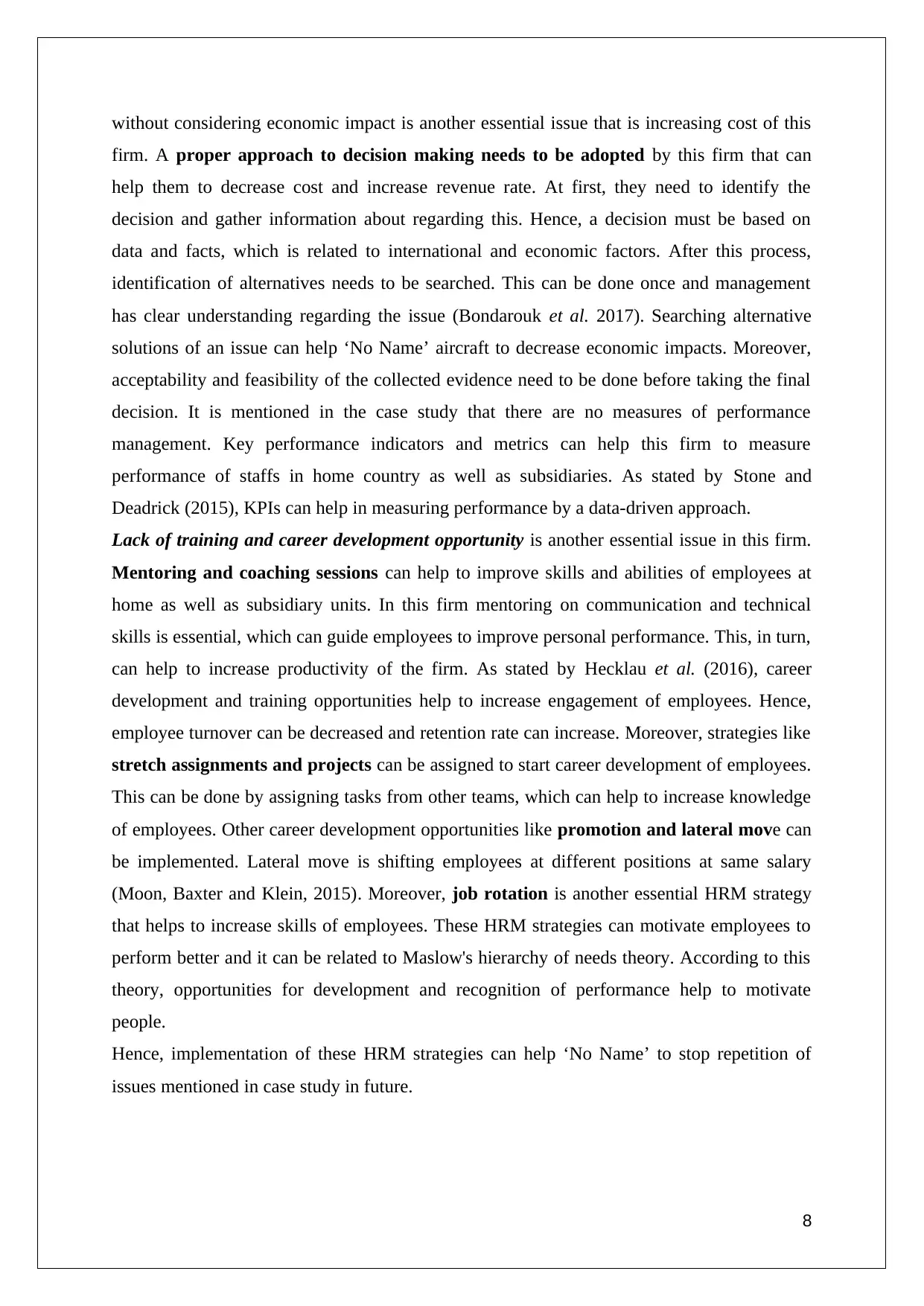
without considering economic impact is another essential issue that is increasing cost of this
firm. A proper approach to decision making needs to be adopted by this firm that can
help them to decrease cost and increase revenue rate. At first, they need to identify the
decision and gather information about regarding this. Hence, a decision must be based on
data and facts, which is related to international and economic factors. After this process,
identification of alternatives needs to be searched. This can be done once and management
has clear understanding regarding the issue (Bondarouk et al. 2017). Searching alternative
solutions of an issue can help ‘No Name’ aircraft to decrease economic impacts. Moreover,
acceptability and feasibility of the collected evidence need to be done before taking the final
decision. It is mentioned in the case study that there are no measures of performance
management. Key performance indicators and metrics can help this firm to measure
performance of staffs in home country as well as subsidiaries. As stated by Stone and
Deadrick (2015), KPIs can help in measuring performance by a data-driven approach.
Lack of training and career development opportunity is another essential issue in this firm.
Mentoring and coaching sessions can help to improve skills and abilities of employees at
home as well as subsidiary units. In this firm mentoring on communication and technical
skills is essential, which can guide employees to improve personal performance. This, in turn,
can help to increase productivity of the firm. As stated by Hecklau et al. (2016), career
development and training opportunities help to increase engagement of employees. Hence,
employee turnover can be decreased and retention rate can increase. Moreover, strategies like
stretch assignments and projects can be assigned to start career development of employees.
This can be done by assigning tasks from other teams, which can help to increase knowledge
of employees. Other career development opportunities like promotion and lateral move can
be implemented. Lateral move is shifting employees at different positions at same salary
(Moon, Baxter and Klein, 2015). Moreover, job rotation is another essential HRM strategy
that helps to increase skills of employees. These HRM strategies can motivate employees to
perform better and it can be related to Maslow's hierarchy of needs theory. According to this
theory, opportunities for development and recognition of performance help to motivate
people.
Hence, implementation of these HRM strategies can help ‘No Name’ to stop repetition of
issues mentioned in case study in future.
8
firm. A proper approach to decision making needs to be adopted by this firm that can
help them to decrease cost and increase revenue rate. At first, they need to identify the
decision and gather information about regarding this. Hence, a decision must be based on
data and facts, which is related to international and economic factors. After this process,
identification of alternatives needs to be searched. This can be done once and management
has clear understanding regarding the issue (Bondarouk et al. 2017). Searching alternative
solutions of an issue can help ‘No Name’ aircraft to decrease economic impacts. Moreover,
acceptability and feasibility of the collected evidence need to be done before taking the final
decision. It is mentioned in the case study that there are no measures of performance
management. Key performance indicators and metrics can help this firm to measure
performance of staffs in home country as well as subsidiaries. As stated by Stone and
Deadrick (2015), KPIs can help in measuring performance by a data-driven approach.
Lack of training and career development opportunity is another essential issue in this firm.
Mentoring and coaching sessions can help to improve skills and abilities of employees at
home as well as subsidiary units. In this firm mentoring on communication and technical
skills is essential, which can guide employees to improve personal performance. This, in turn,
can help to increase productivity of the firm. As stated by Hecklau et al. (2016), career
development and training opportunities help to increase engagement of employees. Hence,
employee turnover can be decreased and retention rate can increase. Moreover, strategies like
stretch assignments and projects can be assigned to start career development of employees.
This can be done by assigning tasks from other teams, which can help to increase knowledge
of employees. Other career development opportunities like promotion and lateral move can
be implemented. Lateral move is shifting employees at different positions at same salary
(Moon, Baxter and Klein, 2015). Moreover, job rotation is another essential HRM strategy
that helps to increase skills of employees. These HRM strategies can motivate employees to
perform better and it can be related to Maslow's hierarchy of needs theory. According to this
theory, opportunities for development and recognition of performance help to motivate
people.
Hence, implementation of these HRM strategies can help ‘No Name’ to stop repetition of
issues mentioned in case study in future.
8

Recommendations and implementation plan
All of the issues that are being faced by this company can be solved by following below-
mentioned recommendation,
Organizing training program for managers of HR departments of headquarter and
subsidiaries of ‘No Name’
It has been found that all the issues that are being faced by ‘No Name’ are related to poor
management of HR department. As an International human resource management consultant,
it is recommended to invite a successful expert with experience in HR management for
providing training to employees. These managers are unable to manage human resources and
this aspect is affecting performance of this. Lack of skilled employees is preventing this
company to meet expectation of their customers. Present HR managers are not taking
initiatives to encourage employees to cooperate with management. These HR managers must
be trained by expert for up-gradation of their skills. This kind of training program helps to
enrich knowledge and performance get improved. These managers must know the process to
motivate employees through effective communication. They must understand that employees
must be encouraged to communicate with each other as this aspect may help them to work in
groups. The training program may make HR managers understand that it is their
responsibility to maintain discrimination-free workplace, where everyone provides respect to
others.
Implementation plan
Actions to be taken Expected outcome Time Span
Providing regular feedback to
employees
Improvement of performance Once in a
week
Arrangement of regular meetings Ensuring employee engagement Once in a
month
Encouraging employees to
communicate with each other
Developing team working skills in
employees
Regular
Encouraging collaboration between
teams and employees
Improving business performance Regular
Communicating with employees to Establishing two-way Once in
9
All of the issues that are being faced by this company can be solved by following below-
mentioned recommendation,
Organizing training program for managers of HR departments of headquarter and
subsidiaries of ‘No Name’
It has been found that all the issues that are being faced by ‘No Name’ are related to poor
management of HR department. As an International human resource management consultant,
it is recommended to invite a successful expert with experience in HR management for
providing training to employees. These managers are unable to manage human resources and
this aspect is affecting performance of this. Lack of skilled employees is preventing this
company to meet expectation of their customers. Present HR managers are not taking
initiatives to encourage employees to cooperate with management. These HR managers must
be trained by expert for up-gradation of their skills. This kind of training program helps to
enrich knowledge and performance get improved. These managers must know the process to
motivate employees through effective communication. They must understand that employees
must be encouraged to communicate with each other as this aspect may help them to work in
groups. The training program may make HR managers understand that it is their
responsibility to maintain discrimination-free workplace, where everyone provides respect to
others.
Implementation plan
Actions to be taken Expected outcome Time Span
Providing regular feedback to
employees
Improvement of performance Once in a
week
Arrangement of regular meetings Ensuring employee engagement Once in a
month
Encouraging employees to
communicate with each other
Developing team working skills in
employees
Regular
Encouraging collaboration between
teams and employees
Improving business performance Regular
Communicating with employees to Establishing two-way Once in
9
⊘ This is a preview!⊘
Do you want full access?
Subscribe today to unlock all pages.

Trusted by 1+ million students worldwide
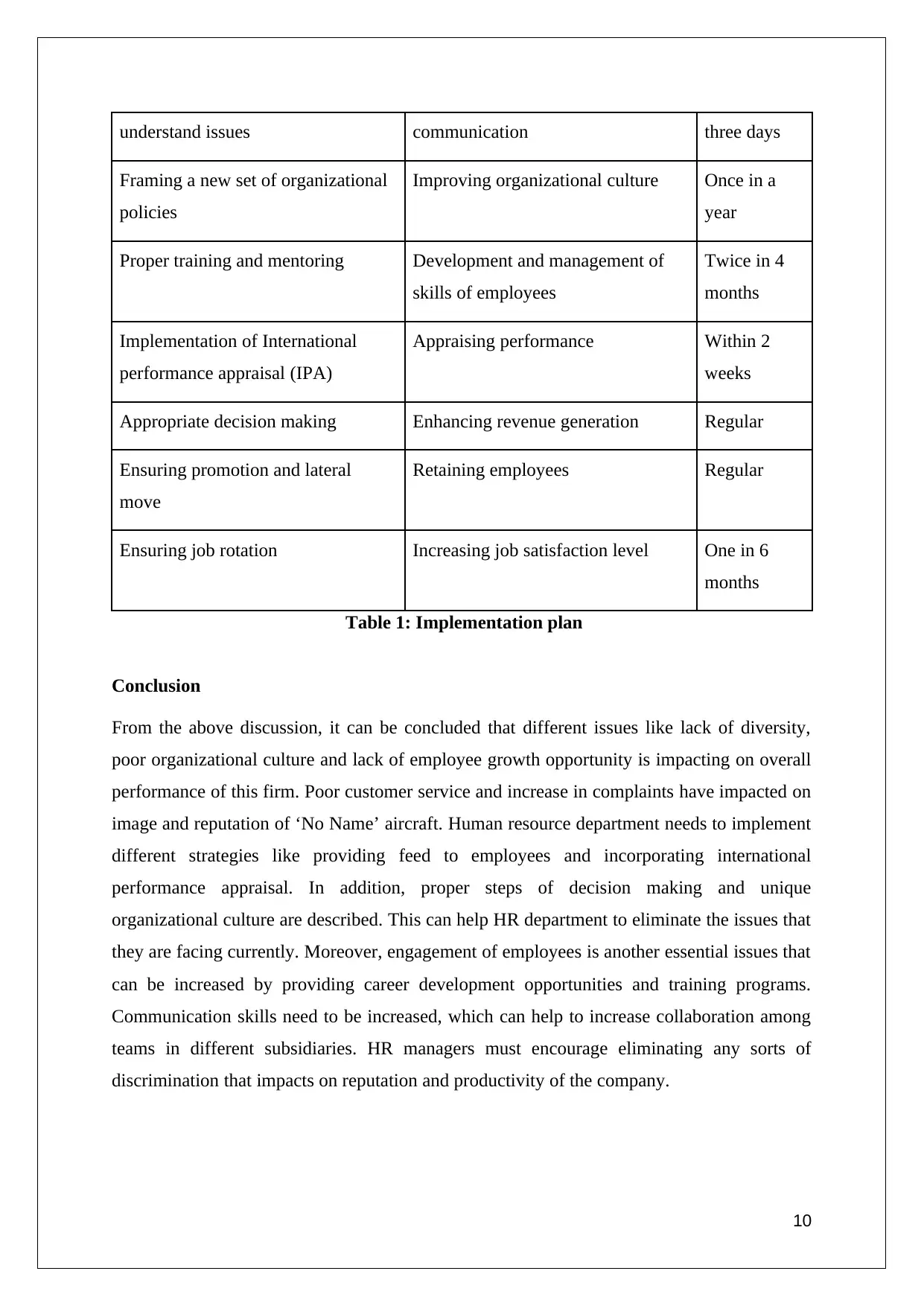
understand issues communication three days
Framing a new set of organizational
policies
Improving organizational culture Once in a
year
Proper training and mentoring Development and management of
skills of employees
Twice in 4
months
Implementation of International
performance appraisal (IPA)
Appraising performance Within 2
weeks
Appropriate decision making Enhancing revenue generation Regular
Ensuring promotion and lateral
move
Retaining employees Regular
Ensuring job rotation Increasing job satisfaction level One in 6
months
Table 1: Implementation plan
Conclusion
From the above discussion, it can be concluded that different issues like lack of diversity,
poor organizational culture and lack of employee growth opportunity is impacting on overall
performance of this firm. Poor customer service and increase in complaints have impacted on
image and reputation of ‘No Name’ aircraft. Human resource department needs to implement
different strategies like providing feed to employees and incorporating international
performance appraisal. In addition, proper steps of decision making and unique
organizational culture are described. This can help HR department to eliminate the issues that
they are facing currently. Moreover, engagement of employees is another essential issues that
can be increased by providing career development opportunities and training programs.
Communication skills need to be increased, which can help to increase collaboration among
teams in different subsidiaries. HR managers must encourage eliminating any sorts of
discrimination that impacts on reputation and productivity of the company.
10
Framing a new set of organizational
policies
Improving organizational culture Once in a
year
Proper training and mentoring Development and management of
skills of employees
Twice in 4
months
Implementation of International
performance appraisal (IPA)
Appraising performance Within 2
weeks
Appropriate decision making Enhancing revenue generation Regular
Ensuring promotion and lateral
move
Retaining employees Regular
Ensuring job rotation Increasing job satisfaction level One in 6
months
Table 1: Implementation plan
Conclusion
From the above discussion, it can be concluded that different issues like lack of diversity,
poor organizational culture and lack of employee growth opportunity is impacting on overall
performance of this firm. Poor customer service and increase in complaints have impacted on
image and reputation of ‘No Name’ aircraft. Human resource department needs to implement
different strategies like providing feed to employees and incorporating international
performance appraisal. In addition, proper steps of decision making and unique
organizational culture are described. This can help HR department to eliminate the issues that
they are facing currently. Moreover, engagement of employees is another essential issues that
can be increased by providing career development opportunities and training programs.
Communication skills need to be increased, which can help to increase collaboration among
teams in different subsidiaries. HR managers must encourage eliminating any sorts of
discrimination that impacts on reputation and productivity of the company.
10
Paraphrase This Document
Need a fresh take? Get an instant paraphrase of this document with our AI Paraphraser
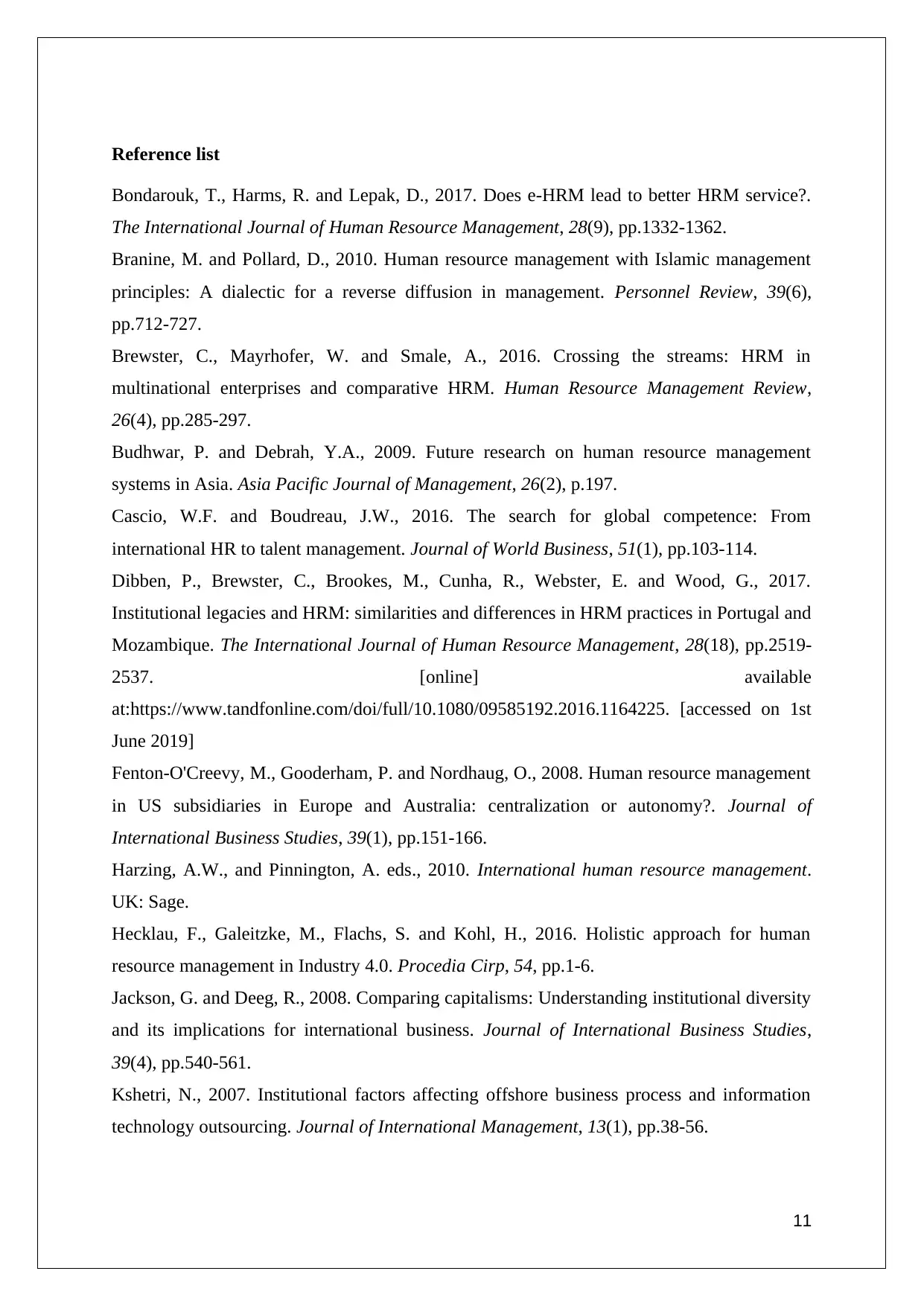
Reference list
Bondarouk, T., Harms, R. and Lepak, D., 2017. Does e-HRM lead to better HRM service?.
The International Journal of Human Resource Management, 28(9), pp.1332-1362.
Branine, M. and Pollard, D., 2010. Human resource management with Islamic management
principles: A dialectic for a reverse diffusion in management. Personnel Review, 39(6),
pp.712-727.
Brewster, C., Mayrhofer, W. and Smale, A., 2016. Crossing the streams: HRM in
multinational enterprises and comparative HRM. Human Resource Management Review,
26(4), pp.285-297.
Budhwar, P. and Debrah, Y.A., 2009. Future research on human resource management
systems in Asia. Asia Pacific Journal of Management, 26(2), p.197.
Cascio, W.F. and Boudreau, J.W., 2016. The search for global competence: From
international HR to talent management. Journal of World Business, 51(1), pp.103-114.
Dibben, P., Brewster, C., Brookes, M., Cunha, R., Webster, E. and Wood, G., 2017.
Institutional legacies and HRM: similarities and differences in HRM practices in Portugal and
Mozambique. The International Journal of Human Resource Management, 28(18), pp.2519-
2537. [online] available
at:https://www.tandfonline.com/doi/full/10.1080/09585192.2016.1164225. [accessed on 1st
June 2019]
Fenton-O'Creevy, M., Gooderham, P. and Nordhaug, O., 2008. Human resource management
in US subsidiaries in Europe and Australia: centralization or autonomy?. Journal of
International Business Studies, 39(1), pp.151-166.
Harzing, A.W., and Pinnington, A. eds., 2010. International human resource management.
UK: Sage.
Hecklau, F., Galeitzke, M., Flachs, S. and Kohl, H., 2016. Holistic approach for human
resource management in Industry 4.0. Procedia Cirp, 54, pp.1-6.
Jackson, G. and Deeg, R., 2008. Comparing capitalisms: Understanding institutional diversity
and its implications for international business. Journal of International Business Studies,
39(4), pp.540-561.
Kshetri, N., 2007. Institutional factors affecting offshore business process and information
technology outsourcing. Journal of International Management, 13(1), pp.38-56.
11
Bondarouk, T., Harms, R. and Lepak, D., 2017. Does e-HRM lead to better HRM service?.
The International Journal of Human Resource Management, 28(9), pp.1332-1362.
Branine, M. and Pollard, D., 2010. Human resource management with Islamic management
principles: A dialectic for a reverse diffusion in management. Personnel Review, 39(6),
pp.712-727.
Brewster, C., Mayrhofer, W. and Smale, A., 2016. Crossing the streams: HRM in
multinational enterprises and comparative HRM. Human Resource Management Review,
26(4), pp.285-297.
Budhwar, P. and Debrah, Y.A., 2009. Future research on human resource management
systems in Asia. Asia Pacific Journal of Management, 26(2), p.197.
Cascio, W.F. and Boudreau, J.W., 2016. The search for global competence: From
international HR to talent management. Journal of World Business, 51(1), pp.103-114.
Dibben, P., Brewster, C., Brookes, M., Cunha, R., Webster, E. and Wood, G., 2017.
Institutional legacies and HRM: similarities and differences in HRM practices in Portugal and
Mozambique. The International Journal of Human Resource Management, 28(18), pp.2519-
2537. [online] available
at:https://www.tandfonline.com/doi/full/10.1080/09585192.2016.1164225. [accessed on 1st
June 2019]
Fenton-O'Creevy, M., Gooderham, P. and Nordhaug, O., 2008. Human resource management
in US subsidiaries in Europe and Australia: centralization or autonomy?. Journal of
International Business Studies, 39(1), pp.151-166.
Harzing, A.W., and Pinnington, A. eds., 2010. International human resource management.
UK: Sage.
Hecklau, F., Galeitzke, M., Flachs, S. and Kohl, H., 2016. Holistic approach for human
resource management in Industry 4.0. Procedia Cirp, 54, pp.1-6.
Jackson, G. and Deeg, R., 2008. Comparing capitalisms: Understanding institutional diversity
and its implications for international business. Journal of International Business Studies,
39(4), pp.540-561.
Kshetri, N., 2007. Institutional factors affecting offshore business process and information
technology outsourcing. Journal of International Management, 13(1), pp.38-56.
11
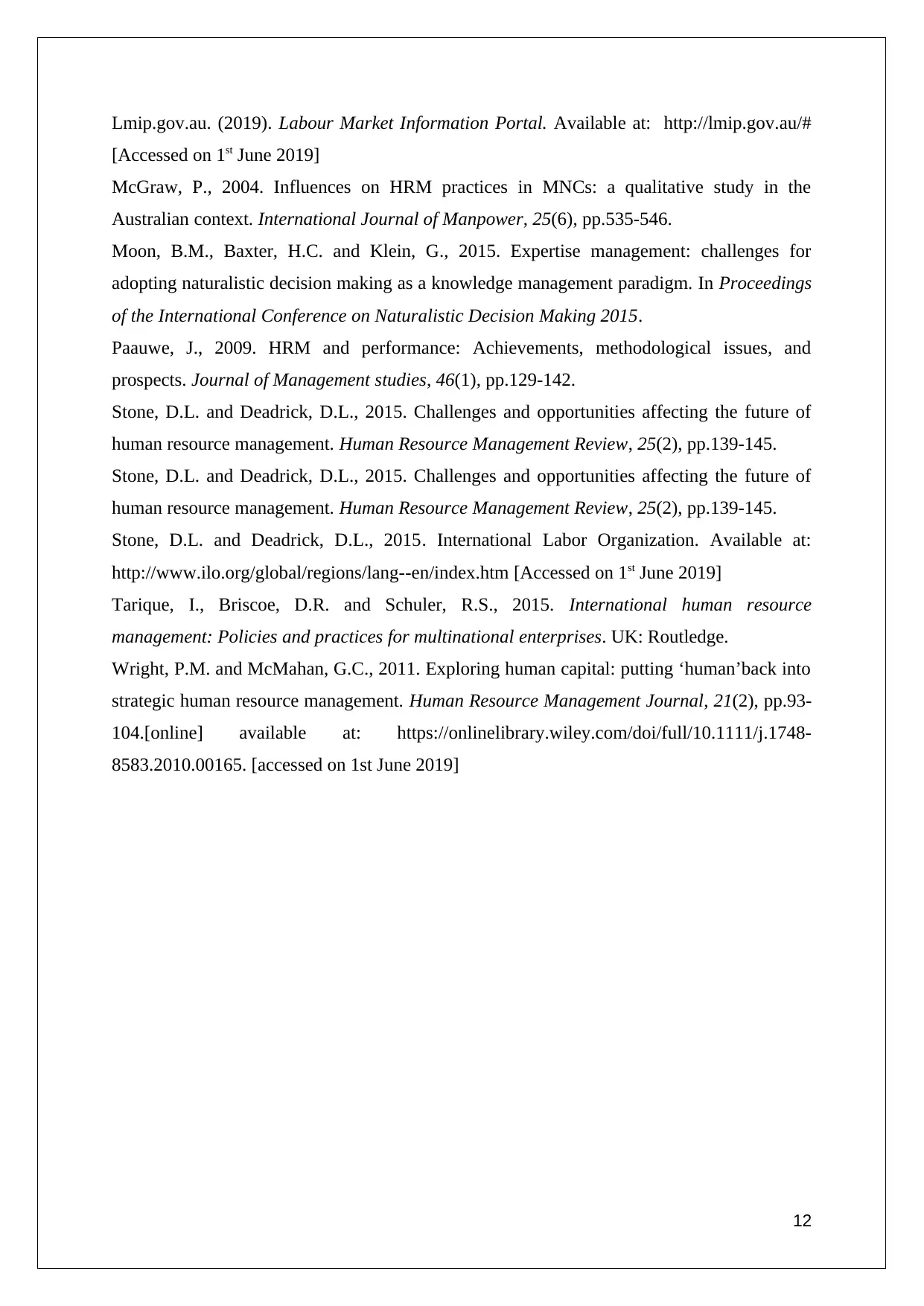
Lmip.gov.au. (2019). Labour Market Information Portal. Available at: http://lmip.gov.au/#
[Accessed on 1st June 2019]
McGraw, P., 2004. Influences on HRM practices in MNCs: a qualitative study in the
Australian context. International Journal of Manpower, 25(6), pp.535-546.
Moon, B.M., Baxter, H.C. and Klein, G., 2015. Expertise management: challenges for
adopting naturalistic decision making as a knowledge management paradigm. In Proceedings
of the International Conference on Naturalistic Decision Making 2015.
Paauwe, J., 2009. HRM and performance: Achievements, methodological issues, and
prospects. Journal of Management studies, 46(1), pp.129-142.
Stone, D.L. and Deadrick, D.L., 2015. Challenges and opportunities affecting the future of
human resource management. Human Resource Management Review, 25(2), pp.139-145.
Stone, D.L. and Deadrick, D.L., 2015. Challenges and opportunities affecting the future of
human resource management. Human Resource Management Review, 25(2), pp.139-145.
Stone, D.L. and Deadrick, D.L., 2015. International Labor Organization. Available at:
http://www.ilo.org/global/regions/lang--en/index.htm [Accessed on 1st June 2019]
Tarique, I., Briscoe, D.R. and Schuler, R.S., 2015. International human resource
management: Policies and practices for multinational enterprises. UK: Routledge.
Wright, P.M. and McMahan, G.C., 2011. Exploring human capital: putting ‘human’back into
strategic human resource management. Human Resource Management Journal, 21(2), pp.93-
104.[online] available at: https://onlinelibrary.wiley.com/doi/full/10.1111/j.1748-
8583.2010.00165. [accessed on 1st June 2019]
12
[Accessed on 1st June 2019]
McGraw, P., 2004. Influences on HRM practices in MNCs: a qualitative study in the
Australian context. International Journal of Manpower, 25(6), pp.535-546.
Moon, B.M., Baxter, H.C. and Klein, G., 2015. Expertise management: challenges for
adopting naturalistic decision making as a knowledge management paradigm. In Proceedings
of the International Conference on Naturalistic Decision Making 2015.
Paauwe, J., 2009. HRM and performance: Achievements, methodological issues, and
prospects. Journal of Management studies, 46(1), pp.129-142.
Stone, D.L. and Deadrick, D.L., 2015. Challenges and opportunities affecting the future of
human resource management. Human Resource Management Review, 25(2), pp.139-145.
Stone, D.L. and Deadrick, D.L., 2015. Challenges and opportunities affecting the future of
human resource management. Human Resource Management Review, 25(2), pp.139-145.
Stone, D.L. and Deadrick, D.L., 2015. International Labor Organization. Available at:
http://www.ilo.org/global/regions/lang--en/index.htm [Accessed on 1st June 2019]
Tarique, I., Briscoe, D.R. and Schuler, R.S., 2015. International human resource
management: Policies and practices for multinational enterprises. UK: Routledge.
Wright, P.M. and McMahan, G.C., 2011. Exploring human capital: putting ‘human’back into
strategic human resource management. Human Resource Management Journal, 21(2), pp.93-
104.[online] available at: https://onlinelibrary.wiley.com/doi/full/10.1111/j.1748-
8583.2010.00165. [accessed on 1st June 2019]
12
⊘ This is a preview!⊘
Do you want full access?
Subscribe today to unlock all pages.

Trusted by 1+ million students worldwide
1 out of 12
Related Documents
Your All-in-One AI-Powered Toolkit for Academic Success.
+13062052269
info@desklib.com
Available 24*7 on WhatsApp / Email
![[object Object]](/_next/static/media/star-bottom.7253800d.svg)
Unlock your academic potential
Copyright © 2020–2025 A2Z Services. All Rights Reserved. Developed and managed by ZUCOL.




